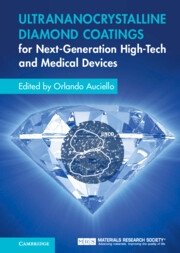Book contents
- Ultrananocrystalline Diamond Coatings for Next-Generation High-Tech and Medical Devices
- Ultrananocrystalline Diamond Coatings for Next-Generation High-Tech and Medical Devices
- Copyright page
- Contents
- Contributors
- Preface
- 1 Fundamentals on Synthesis and Properties of Ultrananocrystalline Diamond (UNCD™) Coatings
- 2 Ultrananocrystalline Diamond (UNCD™) Film as a Hermetic Biocompatible/Bioinert Coating for Encapsulation of an Eye-Implantable Microchip to Restore Partial Vision to Blind People
- 3 Science and Technology of Ultrananocrystalline Diamond (UNCD™) Coatings for Glaucoma Treatment Devices
- 4 Science and Technology of Novel Integrated Biocompatible Superparamagnetic Oxide Nanoparticles Injectable in the Human Eye and External Ultrananocrystalline Diamond (UNCD™)-Coated Magnet for a New Retina Reattachment Procedure
- 5 Science and Technology of Biocompatible Ultrananocrystalline Diamond (UNCD™) Coatings for a New Generation of Implantable Prostheses
- 6 Science and Technology of Novel Ultrananocrystalline Diamond (UNCD™) Scaffolds for Stem Cell Growth and Differentiation for Developmental Biology and Biological Treatment of Human Medical Conditions
- 7 New Generation of Li-Ion Batteries with Superior Specific Capacity Lifetime and Safety Performance Based on Novel Ultrananocrystalline Diamond (UNCD™)-Coated Components for a New Generation of Defibrillators/Pacemakers and Other Battery-Powered Medical and High-Tech Devices
- 8 Science and Technology of Integrated Nitride Piezoelectric/Ultrananocrystalline Diamond (UNCD™) Films for a New Generation of Biomedical MEMS Energy Generation, Drug Delivery, and Sensor Devices
- 9 Science and Technology of Integrated Multifunctional Piezoelectric Oxides/Ultrananocrystalline Diamond (UNCD™) Films for a New Generation of Biomedical MEMS Energy Generation, Drug Delivery, and Sensor Devices
- 10 Biomaterials and Multifunctional Biocompatible Ultrananocrystalline Diamond (UNCD™) Technologies Transfer Pathway
- Index
- References
6 - Science and Technology of Novel Ultrananocrystalline Diamond (UNCD™) Scaffolds for Stem Cell Growth and Differentiation for Developmental Biology and Biological Treatment of Human Medical Conditions
Published online by Cambridge University Press: 08 July 2022
- Ultrananocrystalline Diamond Coatings for Next-Generation High-Tech and Medical Devices
- Ultrananocrystalline Diamond Coatings for Next-Generation High-Tech and Medical Devices
- Copyright page
- Contents
- Contributors
- Preface
- 1 Fundamentals on Synthesis and Properties of Ultrananocrystalline Diamond (UNCD™) Coatings
- 2 Ultrananocrystalline Diamond (UNCD™) Film as a Hermetic Biocompatible/Bioinert Coating for Encapsulation of an Eye-Implantable Microchip to Restore Partial Vision to Blind People
- 3 Science and Technology of Ultrananocrystalline Diamond (UNCD™) Coatings for Glaucoma Treatment Devices
- 4 Science and Technology of Novel Integrated Biocompatible Superparamagnetic Oxide Nanoparticles Injectable in the Human Eye and External Ultrananocrystalline Diamond (UNCD™)-Coated Magnet for a New Retina Reattachment Procedure
- 5 Science and Technology of Biocompatible Ultrananocrystalline Diamond (UNCD™) Coatings for a New Generation of Implantable Prostheses
- 6 Science and Technology of Novel Ultrananocrystalline Diamond (UNCD™) Scaffolds for Stem Cell Growth and Differentiation for Developmental Biology and Biological Treatment of Human Medical Conditions
- 7 New Generation of Li-Ion Batteries with Superior Specific Capacity Lifetime and Safety Performance Based on Novel Ultrananocrystalline Diamond (UNCD™)-Coated Components for a New Generation of Defibrillators/Pacemakers and Other Battery-Powered Medical and High-Tech Devices
- 8 Science and Technology of Integrated Nitride Piezoelectric/Ultrananocrystalline Diamond (UNCD™) Films for a New Generation of Biomedical MEMS Energy Generation, Drug Delivery, and Sensor Devices
- 9 Science and Technology of Integrated Multifunctional Piezoelectric Oxides/Ultrananocrystalline Diamond (UNCD™) Films for a New Generation of Biomedical MEMS Energy Generation, Drug Delivery, and Sensor Devices
- 10 Biomaterials and Multifunctional Biocompatible Ultrananocrystalline Diamond (UNCD™) Technologies Transfer Pathway
- Index
- References
Summary
Biomaterials are being investigated to produce platform as scaffolds for cell/tissue growth and differentiation/regeneration. Cell-materials, chemical and biological interactions enable the application of more functional materials in the area of bioengineering, providing a pathway to novel treatment of humans suffering from tissue/organ damage and facing limitation of donation organs. Many studies were done on the tissue/organ regeneration. Development of new scaffolds for cell/tissue regeneration is a key R&D field. This chapter focuses on describing R&D on the novel ultrananocrystalline diamond (UNCD) film as a unique biomaterial for scaffolds for developmental biology. Recent research showed that cells grown on the surface of UNCD-coated culture dishes are similar to cell culture dishes with little retardation, indicating UNCD films have no or little inhibition on cell proliferation and are potentially appealing as substrate/scaffold materials. The mechanisms of cell adhesion on UNCD surfaces are proposed based on the experimental results. The comparisons of cell cultures on diamond-powder-seeded culture dishes and on UNCD-coated dishes with matrix-assisted laser desorption/ionization - time-of-flight mass spectroscopy (MALDI-TOF MS) and X-ray photoelectron spectroscopy (XPS) analyses provided valuable data to support the mechanisms proposed to explain the adhesion and proliferation of cells on the surface of UNCD scaffolds.
Keywords
- Type
- Chapter
- Information
- Ultrananocrystalline Diamond Coatings for Next-Generation High-Tech and Medical Devices , pp. 175 - 196Publisher: Cambridge University PressPrint publication year: 2022



